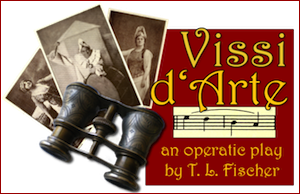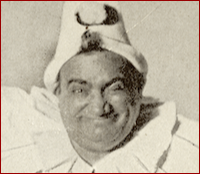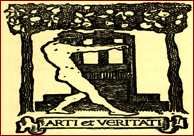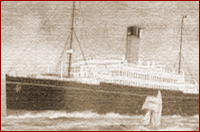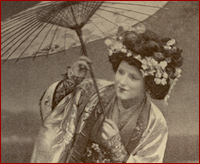
Music
The music of Vissi d’Arte is incorporated by libretti and themes, almost as if written especially for the play. Abridged versions of longer arias could be used. This would not be overly heretical, since abridged versions were commonly performed for early recordings.
Act One
• The Introductory Medley
The music cycles through brief selections from the Overture to Strauss’s Die Fledermaus, the Prelude to Bizet’s Carmen, the dramatic opening of the “Ride of the Valkyries” from Wagner’s Die Walküre, and the bittersweet Meditation from Massenet’s Thaïs. The buoyant mood is revived by the “can- can” music from the Overture to Jacques Offenbach’s Orpheus in the Underworld.
• “Entrance Of The Gods into Valhalla” (approximately the first thirty seconds) from Wagner’s Das Rheingold
Scenario: The flurry of drums accompanies Ghost Caruso’s conjuring of Ghost Frances.
• Overture from Rossini’s The Barber of Seville
Scenario: Accompanies Caruso’s misdirected flirtation with a woman in the Central Park Zoo Monkey House, and his subsequent, ignoble flight from a police officer.
• “La donna è mobile” from Verdi’s Rigoletto
Scenario: Ghost Frances conjures this music to accompany her accusation that Ghost Caruso, when alive, was a womanizer.
• Overture from Mozart’s Die Zauberflöte
Scenario: A selection accompanies Ghost Enrico’s conjuring of a city street scene in 1908, where the main characters are introduced as they approach a theater entrance.
• “E soffito...e pareti . . .” (instrumental beginning only) from Puccini’s Madama Butterfly
Scenario: This instrumental music accompanies the transition to the theater interior, where the characters have gathered for a rehearsal.
• “Vogliatemi bene” (soprano’s beginning only) from Puccini’s Madama Butterfly
Scenario: In the beginning of this duet, Cho-cho-san is asking Pinkerton to love her “a little,” and here—in the context of the rehearsal—it acts as the introduction of the stormy love affair between Toscanini and Farrar.
• “Là ci darem la mano” from Mozart’s Don Giovanni
Scenario: Although Farrar sings this duet of seduction and demurral with Scotti, it is clear that the soprano is really addressing the conductor, Toscanini.
• “Je veux vivre . . .” from Gounod’s Roméo et Juliette
Scenario: Toscanini and Farrar dance a fantasy waltz to the accompaniment of soprano Alda’s singing.
• “Dawn & Siegfried’s Rhine Journey” from Wagner’s Götterdämmerung
Scenario: With heroic swells from this music in the background, Fremstad-Gadski (in full Brünnhilde regalia) suddenly gives Toscanini an exuberant hug—to his obvious discomfort. “Those Italians” have been accepted into the New York City opera scene.
• “Voi Che Sapete” from Mozart’s The Marriage of Figaro
Scenario: Gatti uses the Mezzo’s singing of this aria in rehearsal as a proxy expression of his feelings for Alda.
• Bridal Chorus from Wagner’s Lohengrin (instrumental version if a chorus is not available)
Scenario: A dazed and confused Alda suddenly finds herself being married, while Ghost Frances tries desperately, but ineffectively, to talk her living self out of it.
• Overture to Mozart’s The Marriage of Figaro
Scenario: This apropos music accompanies the transition to the Hotel Knickerbocker dining room for the wedding celebration.
• “Largo al factotum” from Rossini’s The Barber of Seville
Scenario: Slightly drunk, the baritone Scotti gives an exuberant, impromptu performance of the famed “Figaro, Figaro, Figaro” to help him describe the life of an in-demand opera star.
The music cycles through brief selections from the Overture to Strauss’s Die Fledermaus, the Prelude to Bizet’s Carmen, the dramatic opening of the “Ride of the Valkyries” from Wagner’s Die Walküre, and the bittersweet Meditation from Massenet’s Thaïs. The buoyant mood is revived by the “can- can” music from the Overture to Jacques Offenbach’s Orpheus in the Underworld.
• “Entrance Of The Gods into Valhalla” (approximately the first thirty seconds) from Wagner’s Das Rheingold
Scenario: The flurry of drums accompanies Ghost Caruso’s conjuring of Ghost Frances.
• Overture from Rossini’s The Barber of Seville
Scenario: Accompanies Caruso’s misdirected flirtation with a woman in the Central Park Zoo Monkey House, and his subsequent, ignoble flight from a police officer.
• “La donna è mobile” from Verdi’s Rigoletto
Scenario: Ghost Frances conjures this music to accompany her accusation that Ghost Caruso, when alive, was a womanizer.
• Overture from Mozart’s Die Zauberflöte
Scenario: A selection accompanies Ghost Enrico’s conjuring of a city street scene in 1908, where the main characters are introduced as they approach a theater entrance.
• “E soffito...e pareti . . .” (instrumental beginning only) from Puccini’s Madama Butterfly
Scenario: This instrumental music accompanies the transition to the theater interior, where the characters have gathered for a rehearsal.
• “Vogliatemi bene” (soprano’s beginning only) from Puccini’s Madama Butterfly
Scenario: In the beginning of this duet, Cho-cho-san is asking Pinkerton to love her “a little,” and here—in the context of the rehearsal—it acts as the introduction of the stormy love affair between Toscanini and Farrar.
• “Là ci darem la mano” from Mozart’s Don Giovanni
Scenario: Although Farrar sings this duet of seduction and demurral with Scotti, it is clear that the soprano is really addressing the conductor, Toscanini.
• “Je veux vivre . . .” from Gounod’s Roméo et Juliette
Scenario: Toscanini and Farrar dance a fantasy waltz to the accompaniment of soprano Alda’s singing.
• “Dawn & Siegfried’s Rhine Journey” from Wagner’s Götterdämmerung
Scenario: With heroic swells from this music in the background, Fremstad-Gadski (in full Brünnhilde regalia) suddenly gives Toscanini an exuberant hug—to his obvious discomfort. “Those Italians” have been accepted into the New York City opera scene.
• “Voi Che Sapete” from Mozart’s The Marriage of Figaro
Scenario: Gatti uses the Mezzo’s singing of this aria in rehearsal as a proxy expression of his feelings for Alda.
• Bridal Chorus from Wagner’s Lohengrin (instrumental version if a chorus is not available)
Scenario: A dazed and confused Alda suddenly finds herself being married, while Ghost Frances tries desperately, but ineffectively, to talk her living self out of it.
• Overture to Mozart’s The Marriage of Figaro
Scenario: This apropos music accompanies the transition to the Hotel Knickerbocker dining room for the wedding celebration.
• “Largo al factotum” from Rossini’s The Barber of Seville
Scenario: Slightly drunk, the baritone Scotti gives an exuberant, impromptu performance of the famed “Figaro, Figaro, Figaro” to help him describe the life of an in-demand opera star.
Act Two
• “Dôme epais le jasmin” (the Flower Duet) from Lakmé by Delibes
Scenario: To help overcome their fear of being torpedoed while at sea in 1914, Caruso coaches some of the others in an extempore meditation session. From his description of a pleasant day of punting on the Thames, we drift into the faraway world of this gorgeous duet.
• Intermezzo from Mascagni’s Cavalleria Rusticana
Scenario: Ballet dancer Rosina Galli dances slowly and gracefully to this poignant music just before Gatti begins his flirtation with the dancer.
• “Celeste Aïda” (excluding initial fanfare) from Verdi’s Aïda
Scenario: This aria highlights Gatti’s thoughts about his wife, and his wife’s ghost’s memories about their relationship. It also acts as a comic platform for Alda, Scotti, and Caruso when the soprano and baritone play “keep away” with Caruso’s helmet from Aïda. “Alda, come on--give me back the hat! What kind of Radames would I be without a hat?”
• Brindisi (“Libiamo ne' lieti calici”) from Verdi’s La traviata
Scenario: This drinking song highlights examples of an attribute shared by Caruso and Alda—a thirst for life.
GHOST ENRICO: “A ‘thirst for life.’ This reminds me of an old saying in Napoli: ‘Drink deeply from the cup of life, ’cause you’ll probably just trip on the rug and spill the rest anyway.’”
GHOST FRANCES: “I think it must lose something in the translation.”
• “Porgi amor” from Mozart’s The Marriage of Figaro (sung by Alda offstage)
Scenario: As if it is the voice of his wife calling to him, this aria heralds Toscanini’s breakup with Farrar, ending their seven-year affair.
• “Un bel di” from Puccini’s Madama Butterfly
Scenario: This poignant-yet-powerful aria follows Toscanini’s breakup with Farrar. After waiting seven years for the conductor to leave his wife and marry her, the diva is heartbroken.
Scenario: To help overcome their fear of being torpedoed while at sea in 1914, Caruso coaches some of the others in an extempore meditation session. From his description of a pleasant day of punting on the Thames, we drift into the faraway world of this gorgeous duet.
• Intermezzo from Mascagni’s Cavalleria Rusticana
Scenario: Ballet dancer Rosina Galli dances slowly and gracefully to this poignant music just before Gatti begins his flirtation with the dancer.
• “Celeste Aïda” (excluding initial fanfare) from Verdi’s Aïda
Scenario: This aria highlights Gatti’s thoughts about his wife, and his wife’s ghost’s memories about their relationship. It also acts as a comic platform for Alda, Scotti, and Caruso when the soprano and baritone play “keep away” with Caruso’s helmet from Aïda. “Alda, come on--give me back the hat! What kind of Radames would I be without a hat?”
• Brindisi (“Libiamo ne' lieti calici”) from Verdi’s La traviata
Scenario: This drinking song highlights examples of an attribute shared by Caruso and Alda—a thirst for life.
GHOST ENRICO: “A ‘thirst for life.’ This reminds me of an old saying in Napoli: ‘Drink deeply from the cup of life, ’cause you’ll probably just trip on the rug and spill the rest anyway.’”
GHOST FRANCES: “I think it must lose something in the translation.”
• “Porgi amor” from Mozart’s The Marriage of Figaro (sung by Alda offstage)
Scenario: As if it is the voice of his wife calling to him, this aria heralds Toscanini’s breakup with Farrar, ending their seven-year affair.
• “Un bel di” from Puccini’s Madama Butterfly
Scenario: This poignant-yet-powerful aria follows Toscanini’s breakup with Farrar. After waiting seven years for the conductor to leave his wife and marry her, the diva is heartbroken.
Act Three
• “Quand je vous aimerai?” (the Habañera) from Bizet’s Carmen
Scenario: Having gone to Hollywood in 1915 to make the silent film version of Carmen with Cecil B. DeMille, the indomitable Farrar shows that she has rebounded, post-Toscanini, with a dynamic performance of the famed Habañera.
• Habañera reprise from end of Act I in Bizet’s Carmen (offstage)
Scenario: The scene has transitioned from the opera stage to the theater wings or backstage in the same performance of Carmen. When the Habañera reprise ends, Caruso is heard to cry out in pain. Caruso enters, holding his arm as he runs into the wings. He declares that Farrar has bitten him! “You keep away from me, Gerry!”
FARRAR: “That is la Carmencita! In Hollywood, Mr. DeMille taught me to find her true, turbulent nature. I do believe I’ve captured her essence!”
ALDA: “Somebody needs to capture you and put you in a straitjacket.”
• “Ride Of The Valkyries” from Wagner’s Die Walküre
Scenario: The Valkyries are onstage with spears waving as this famous music begins, but they are interrupted by an announcement that the USA has declared war on Germany. Afterward, the music resumes briefly as the Valkyries are enveloped by darkness.
• Intermezzo from Mascagni’s L’Amico Fritz
Scenario: Another big announcement: For the first time, at age 45, Enrico Caruso has married!
• “Toréador, en garde” from Bizet’s Carmen
Scenario: Coinciding with jokes about newly married Caruso having a “ring through the nose,” several of the stars play at charging bull during an informal Carmen rehearsal.
• “Vesti la giubba” from Leoncavallo’s Pagliacci
Scenario: Despite being in terrible pain due to his oncoming illness, Caruso “goes on with the show” for a performance attended by the visiting Toscanini.
• “E lucevan le stelle” from Puccini’s Tosca
Scenario: In a classically operatic death scene, Caruso is on his death bed, looking out a nearby window, while his wife Dorothy holds his hand, distraught. Caruso steps from his bed, unnoticed by Dorothy because it is only in the dying man’s imagination that this happens. He sings this beautiful farewell to life.
• “Vissi d’arte” from Puccini’s Tosca
Scenario: Ghost Enrico and Ghost Frances give their farewells by reminding us again to cherish life. Ghost Frances tell us: “No matter how ill-used you feel at times, no matter what tribulations you face, take refuge wherever it is that you find beauty. Open your mind to the music and drama and passion of life! And don’t miss one single note.” Farrar accents this sentiment by singing “Vissi d’arte.”
Scenario: Having gone to Hollywood in 1915 to make the silent film version of Carmen with Cecil B. DeMille, the indomitable Farrar shows that she has rebounded, post-Toscanini, with a dynamic performance of the famed Habañera.
• Habañera reprise from end of Act I in Bizet’s Carmen (offstage)
Scenario: The scene has transitioned from the opera stage to the theater wings or backstage in the same performance of Carmen. When the Habañera reprise ends, Caruso is heard to cry out in pain. Caruso enters, holding his arm as he runs into the wings. He declares that Farrar has bitten him! “You keep away from me, Gerry!”
FARRAR: “That is la Carmencita! In Hollywood, Mr. DeMille taught me to find her true, turbulent nature. I do believe I’ve captured her essence!”
ALDA: “Somebody needs to capture you and put you in a straitjacket.”
• “Ride Of The Valkyries” from Wagner’s Die Walküre
Scenario: The Valkyries are onstage with spears waving as this famous music begins, but they are interrupted by an announcement that the USA has declared war on Germany. Afterward, the music resumes briefly as the Valkyries are enveloped by darkness.
• Intermezzo from Mascagni’s L’Amico Fritz
Scenario: Another big announcement: For the first time, at age 45, Enrico Caruso has married!
• “Toréador, en garde” from Bizet’s Carmen
Scenario: Coinciding with jokes about newly married Caruso having a “ring through the nose,” several of the stars play at charging bull during an informal Carmen rehearsal.
• “Vesti la giubba” from Leoncavallo’s Pagliacci
Scenario: Despite being in terrible pain due to his oncoming illness, Caruso “goes on with the show” for a performance attended by the visiting Toscanini.
• “E lucevan le stelle” from Puccini’s Tosca
Scenario: In a classically operatic death scene, Caruso is on his death bed, looking out a nearby window, while his wife Dorothy holds his hand, distraught. Caruso steps from his bed, unnoticed by Dorothy because it is only in the dying man’s imagination that this happens. He sings this beautiful farewell to life.
• “Vissi d’arte” from Puccini’s Tosca
Scenario: Ghost Enrico and Ghost Frances give their farewells by reminding us again to cherish life. Ghost Frances tell us: “No matter how ill-used you feel at times, no matter what tribulations you face, take refuge wherever it is that you find beauty. Open your mind to the music and drama and passion of life! And don’t miss one single note.” Farrar accents this sentiment by singing “Vissi d’arte.”
Vissi d’Arte is on file with the United States Copyright Office; the registration number is PAu2-909-657. All rights are reserved to the copyright holder(s) or their assignees.

